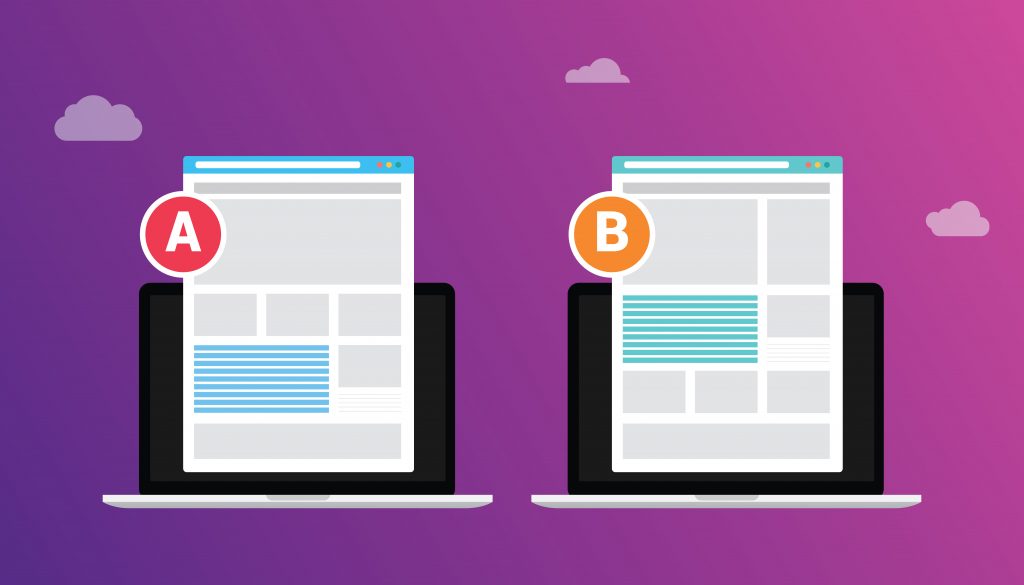Copywriting has traveled a long distance since the “big idea” times of the Mad Men…
What is eCommerce A/B Testing?
eCommerce A/B testing is a scientific process of assessing a marketing variable compared to a control. The process takes place when brands display a percentage of users, either the variable or control edition of a marketing asset. If executed properly, this practice helps businesses assess the efficiency of a variable related to the control.
In general, this eCommerce testing method produces an ongoing circle of optimization and contributes to brighter marketing decisions.
eCommerce Testing Ideas
With various advancements in eCommerce and marketing technology, brands can A/B test nearly all assets. However, we’ve observed that some specific areas are especially well suited for testing.
eCommerce Website

Calls to Action
Consider assessing the color, font-weight, size, capitalization, and shape of the button. Each factor influences users in a different manner, so make sure to take your time to evaluate the ways to continue getting better.
Page Layouts
Assess heading, form, button, and image placement. All these elements add to the overall user experience helping to make or break the purchase process.
We keep evaluating checkout pages and product detail as a part of a regular eCommerce AB testing process. These pages give a high conversion rate for brands. So, it should be the center of gravity for future success.
Product Imagery
Testing the layout and content of the images of your product can drastically influence the purchasing decision of a customer. Consider assessing lifestyle vs outlying product images, on your product detail pages. Furthermore, you can analyze if user-generated pictures work better than branded imagery in multiple places throughout your store.
Pricing Strategies
Testing individual or bundling pricing can support brands thoroughly comprehend how these essential features influence conversion directly. If feasible, we encourage brands to estimate their pricing/conversion relationships and analyze how they eventually affect profitability. You may discover that you can alter pricing to improve conversion without impacting profitability.
Promotional Offers
Consider testing discounts, free shipping, and extra perks across your website. Analyzing these factors can provide better insight into what resonates with your consumers. You can then utilize this data to notify future marketing promotions.

Emails templates
Template design can significantly affect eCommerce email engagement. Evaluate the template with similar subject lines and messaging to understand what formats allow the best marketing promotion. Consider testing the placement of your CTAs, logo, banner imagery, and body of the message.
Subject Lines & Preview Text
One of the most clear-cut elements of email for testing is subject lines & preview text. Assessing various email subject lines can help you recognize what version gets a higher open or click rate. Examine your results and then apply the subject line that will fetch you maximum interaction.
Creative Imagery
Test product highlights, banner imagery, and additional graphic components within your email content to estimate what drives your users to convert. Even though content varies from email to email, marketers can apply this information to know the trends and notify prospective marketing correspondence.
How to Run an A/B Test

Choose a Variable
While initiating your A/B test, there are some of the settings to determine. You will require to determine your variable first, just like an experiment. The variable must be the single thing that is unique between your two alternatives.
Set Distribution Percentages
After resolving what you are testing, establish your distribution rates. We suggest sending Version A & Version B, each to about 15% of your audience. Following the come back of your results, the remaining 70% of your audience will receive the winning version.
Determine a Winning Metric & Duration
Following, you’ll need to establish the winning metric, as a standard that you will utilize to determine your winner. An example of our winning metric in the email subject line test is “opens by delivered.” HubSpot lets you pick from three winning metrics: clicks by delivered opens by delivered or clicks by opens.
You then require setting the duration of your test. We usually suggest longer test times to make sure your results are accurate.
Set Fallbacks
Lastly, keep in mind to set your fallbacks. Like any other regular experiment, things can go wrong. The size of your sample may be too small to produce reliable results, or they may be uncertain. Consequently, it’s best to establish the version you require to send if you run into any of these problems.
Statistical Importance and Data Validity
Even though we strongly believe in the advantages eCommerce a/b testing can give, we advise you to assure that sample testing sizes are large enough to generate statistically significant conclusions. The testing will be invalid in case your audience is not big enough.
A/B testing is based upon numbers and alterations are only made if the data backs it up. While testing eCommerce websites and emails, you will generally require an enormous user base to produce a representative sample size.
In general, eCommerce A/B testing is a time taking process that requires firm dedication and attention. In case you need any help in developing a roadmap to operate your A/B testing or want to know which A/B testing tools to use, we would be pleased to help! Don’t forget to contact us through the comment section given below.








Leave a Reply